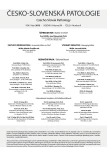Experimental stab wound
Authors:
Miroslav Hirt 1; František Vorel 2; Michal Zelený 1
Authors place of work:
Ústav soudního lékařství, Lékařské fakulty Masarykovy univerzity a Fakultní nemocnice u sv. Anny v Brně.
1; Zdravotně sociální fakulta, Jihočeská univerzita v Českých Budějovicích a Soudnělékařské oddělení Nemocnice České Budějovice, a. s.
České Budějovice.
2
Published in the journal:
Soud Lék., 60, 2015, No. 1, p. 2-3
Category:
Původní práce
Summary
Stab wounds caused by knives and daggers are usually of different appearances. The knife wound has one edge sharp while the second one is blunt. The wound caused by blow of dagger has both edges sharp. The forensic expert must very often decide whether the knife or dagger was used. The aim of this experimental work was to show how a single-edged knife penetrates the skin and causes the wound typical for the double-edged dagger. The fact was verified. The wound typical for dagger can be found if the knife is used only according to the scheme. The forensic expert can say that a one cutting edge knife was used if the one edge of wound is squared and the other one is sharp. If the both of them are sharp, forensic expert must be very careful in his decision.
Key words:
stab wounds – knife – dagger – forensic expertise.
Zdroje
1. Procházka I. Poranění ostrým předmětem – rány řezné, sečné, bodné. in: Kolektiv autorů. Soudní lékařství. Praha: Grada Publishing; 1999: 158.
2. Knight B. Forensic Pathology. Melbourne, Auckland: Edward Arnold London; 1991: 142.
Štítky
Patologie Soudní lékařství ToxikologieČlánek vyšel v časopise
Soudní lékařství

2015 Číslo 1
Nejčtenější v tomto čísle
- Kritéria pro jmenování znalců pro obor zdravotnictví odvětví soudní lékařství
- Nekroptický případ hypoplázie/dysplázie mozku
- Experimentální bodné poranění
- Pribudliny v alkoholických nápojoch a ich význam pre súdnolekárske posudzovanie opitosti
